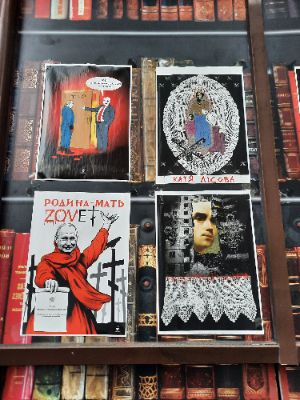From Glen Johnson In Ukraine: Update on the counter offensive.

Glen Johnson 07.11.2023 Counter-offensive
BUCHAREST, Romania -- At the end of September, Nataliya (24), a paramedic from Kharkiv, packed a suitcase with only a few of her belongings: essential documents, a scattering of summer and winter clothes, books by Haruki Murakami and the Ukrainian poet Taras Shevchenko – and her favourite lamp.
She packed her car and headed west, bound for the Ukrainian city of Lviv.
From there, like so many of her compatriots before, she crossed the Carpathian Mountains, settling in Slovakia. She found a job on an assembly line in a factory producing smart home products.
“I don’t see a decent future in Ukraine for at least the next 10 years. I don’t want to raise my children or waste my life there,” said Nataliya. “Crises, devastation, crime, and a bankrupt country. And with a government like we have now, this will never end.”
But the principal reason for her leaving Ukraine some 20 months into the war was Kyiv’s early-September announcement that women with medical or pharmaceutical qualifications had to register at military enlistment offices.
“I was so angry at our government,” said Nataliya. “It seems to me that something could have been done to prevent this war in the first place; or that [the public] could have been adequately prepared for this turn of events.”
Since October 1, women like Nataliya can be called up to military service at any time and are now forbidden from leaving the country without special permission.
It certainly does not sound like the behaviour of a government that is winning a war.
Ukraine’s manpower problem has been clear for a year now. The authorities are desperate to rejuvenate their beleaguered forces, which have been savaged, suffering devastating battlefield losses.
One military advertisement, widely broadcast, shows a man’s fingers unzipping a woman’s black leather dress while bathed in red light. It cuts to a mother and daughter smiling in a kitchen. Finally, the woman is depicted in full military kit.
The accompanying voiceover says: “A true woman should be passionate in the bedroom, a gracious hostess in the kitchen, and a defender on the frontlines. Join the Armed Forces of Ukraine.”
It seems only a matter of time before women more generally are mobilized: the average age of a Ukrainian soldier is reportedly 43 years old.
The regime in Kyiv, which appears beholden to the ultra-nationalists and is led by the increasingly unhinged president, Volodomyr Zelensky, does not appear to care how much blood the country sheds.
Glory to Ukraine. Glory to the heroes. Ukraine above all.
And people appear to be fleeing this nonsense in droves.
Dmitry (32), an Odessa native, paid around US$5000 for a medical certificate deeming him unfit for service, then crossed the border into Romania midway through September, where he started looking for work on cargo ships. He said he had heard of bribes reaching US$12,000.
“[Mobilization] is a death sentence,” he said. “I refuse to be sent to eastern Ukraine to die in a trench.”
He said Zelensky only cared about power, money and fame. About himself.
“If Russia does attack Odessa, then I will have to go back to fight, because that is my home,” he said. “But I am not willing to die for the politicians in Kyiv and their puppeteers inside Ukraine: the nationalists, fascists.”
Despite Kyiv vowing to crack down on the system of bribes that facilitates fighting aged men leaving the country, there were around a dozen Ukrainian men staying in the same hostel as Dmitry, all of whom had bribed their way out of the country.
He talks about what amounts to abduction: soldiers and police hauling men from street corners and homes and bundling them into vans, amid shrieked cries for help. One recent video appeared to show a military recruitment officer severely beating an unwilling conscript in a barracks.
“Yes, this is all happening,” said Dmitry.
And it is happening because Ukraine has suffered staggering casualties, almost certainly far in excess of the Russian side.

KILL ZONE
On June 4, Ukraine launched its “much anticipated counter-offensive”.
It has been a disaster.
Who could have guessed?
One video sourced late September from a Russian Telegram channel, Empire Z, showed dozens of recently destroyed vehicles in the Rabotyne-Verbove sector, where Ukraine “breached” Russia’s first defensive line in one location at the start of September.
Some still burn, sat useless on the wide-open steppe, itself a desolate and cratered lunar landscape. Who knows how many millions of pieces of artillery have been pumped into Ukraine’s black soil?
While the “breach” generated breathless headlines in Western media, it effectively saw Ukrainian troops drawn further into a low-ground kill-zone outside Verbove and moving at snail’s pace away from Tokmak, an important logistics hub – ringed by defenses – on the road to Melitopol.
For five months, Ukraine has been hitting its head against a brick wall in Zaporizhzhia, at a massive cost in both men and materiel. None of the counter-offensive’s objectives have been achieved.
And some Western military analysts are resorting to risible explanations for what went wrong.
“Putin may have ordered the Russian military command to hold all Russia’s initial defensive positions,” wrote the neo-conservative Institute for the Study of War (ISW) in late September, “to create the illusion that Ukrainian counter-offensives have not achieved any tactical or operational effects despite substantial Western support.”
There is nothing illusory about it: Russia built formidable defenses and fought to hold them, like it or not. Insanely, Ukraine launched its offensive almost entirely absent air support, with troops given crash courses by NATO.
Ukrainska Pravda abandoned reality entirely, reporting at the end of September that Ukrainian troops had reached “Russia’s last defensive line in Zaporizhzhia”. The ISW’s interactive map, below, shows just how false that claim was.

Meantime, Mediazona, which, alongside the BBC’s Russia service, tracks Russian casualties, has compiled data which indicates that Moscow’s death rates are at their lowest since the beginning of the war. This is almost certainly a function of the vast defenses that were built in Zaporizhzhia and the flexible defense employed by the Russian army.
With winter just around the corner, Kyiv is likely looking at one final push, to revive flagging Western interest in its cause.
Recent fighting around Kherson, where Ukraine has managed to establish a small bridgehead on the left-bank of the Dnipro River, likely indicates that a major, but high-risk, crossing attempt could be coming. Kyiv’s allies have supplied it with bridge laying tanks and pontoon bridges, notably the M3 Amphibious Rig, which can also act as a ferry.
But Russia has also moved onto an offensive posture, particularly around Avdiivka in Donetsk Province. That city is basically a fortress, with Ukrainian forces dug in, bunkers and tunnels running arterial beneath the city.
Russia has taken heavy casualties on approach, particularly in fighting for the slag heap in the city’s north, a formidable high-ground position. Videos shared on Ukrainian Telegram channels show dozens of damaged and destroyed Russian vehicles in the area.
Moscow has presumably calculated that high losses are an acceptable price to pay. Capturing Avdiivka would relieve pressure of the nearby, Russian-occupied city of Donetsk and deliver a significant blow to Ukrainian morale.
Pressuring the city from the north and south, Moscow appears to be turning Avdiivka into another Bakhmut-style meat grinder. And the Ukrainian leadership – which is more than willing to sacrifice blood for soil – looks set to fall into the trap, having recently sent reinforcements from Zaporizhzhia.
There will be no Yevgeny Prigozhin, the former Wagner Group head, providing morbid entertainment this time around, having departed this mortal coil in flaming wreckage after his Embracer Legacy 600 private plane plummeted some 20,000 near-vertical feet at the end of August.
Regardless, it is clear that Ukraine’s counter-offensive has been a catastrophe. Again, who could have guessed?
Well, US intelligence agencies. And anyone with a brain that has not been totally fried by NATO propaganda.
Midway through April, heavily armed federal agents, surveillance aircraft overhead, raided a house in Massachusetts. Local television channels broadcast footage of 21-year-old Airman First Class Jack Teixeira being escorted from the property. He was believed to have been behind a February leak of classified US intelligence documents, some of which provided a bleak view of Ukraine’s looming counter-offensive.
The Washington Post cited the documents as assessing that “enduring Ukrainian deficiencies in training and munitions supplies probably will strain progress and exacerbate casualties during the offensive,” resulting in only “modest territorial gains”.
Regardless, US President Joe Biden’s administration insisted that Ukraine launch its offensive, to hell with the death toll. Hyper-active Western media created an environment of heightened expectation, while acting as a pressure point on Kyiv.
The constant pressure certainly irritated Mykhailo Podolyak, an advisor to Zelensky. He very publicly blew a fuse on Twitter last April, inadvertently saying the quiet part out loud: Ukraine was in no position to launch its “much anticipated counter-offensive”.
“When will the counter-offensive start? In which direction will it be? How many people and equipment will there be? What is the battle plan? Journalists ask the same questions of everyone who can be called an ‘official’,” wrote Podolyak. “Meanwhile, ordinary Ukrainians who left civilian life to defend their country are preparing to claim their home day after day, but they do not understand where the promised ammunition, aircraft and long-range missiles are…”
It is worth mentioning that Ukraine is a multi-layered war, with local, regional and global dimensions, somewhat similar to the war in Syria. On the global, or geopolitical level, the US/NATO is waging a proxy war against Russia, with Ukraine providing the bodies. It is a long-term, reckless project.
Not that the psychopaths in Brussels, London and Washington care.
“Here’s what we’ve gotten for our investment. We haven’t lost one soldier. We reduced the combat power of the Russian army by 50%, and not one of us has died in that endeavor,” Republican Senator Lindsey Graham told 60 Minutes during a visit to Kyiv last year. “This is a great deal for America.”
It is, however, not a “great deal” for Ukraine.
It has suffered horrific losses. Some 300,000 people have become disabled since the war began, which will have grievous long-term consequences. A kill ratio of two-to-one, and not in Ukraine’s favour, seems likely. Millions have left the country, a majority of whom will never return. Many Ukrainians are learning the hard way that the West is not the paradise that local media and politicians presented it as following the Maidan uprising of 2013-14, which bought together anti-corruption / pro-European protestors and increasingly violent elements of the far right.
“It’s not so easy for us in Canada. My husband works hard, but he only has two days off a month and still we only have enough for rent and food – but we are safe,” said Irina, from Odessa, who moved to Toronto with her husband and two children midway through last year. “My husband got a job as a mechanic at a battery recycling plant…the work is not easy and there are lead emissions. Now we understand that Canada was not the best choice, but it is very difficult to move somewhere again. Especially with children.”
Meantime, Ukraine’s economy is in tatters, unemployment has skyrocketed. Kyiv has used its powers under martial law to pass legislation brazenly attacking workers’ rights – including the suspension of collective bargaining and the introduction of provisions that allow employers to change working conditions at will.
The deeply unpopular Law 5371, promulgated by Zelensky last year, impacts some 70% of Ukraine’s workforce, who are no longer covered by the national labour code. They will be forced to ‘negotiate’ contracts individually with their employers. Bosses can fire employees at will.
Corruption is rampant. Zelensky’s regime is increasingly authoritarian and has largely capitulated to the ultra-nationalists/ neo-fascists. His vision for Ukraine sounds truly dystopic, having last year announced that the country would become a “big Israel” where armed forces would be present in, “all institutions, supermarkets, cinemas, there will be people with weapons”.
It only got worse from there.
“American brands [such] as Starlink or Westinghouse have already become part of our, Ukrainian, way,” said Zelensky last January. “Brilliant defense systems, such as HIMARS or Bradleys, are already uniting our history of freedom with your enterprises…everyone can become a big business by working with Ukraine. In all sectors: from weapons and defense to construction, from communications to agriculture…”
Ironically, the ultra-nationalists – in collusion with the West – have played a major part in reducing Ukraine to a Western dependency, a pauper rump state devoid of sovereignty. Just with massive casualties.
Slava Ukraini!
It could all have been avoided.

NEUTRALITY
On April 10, 2022, Britain’s then-prime minister, Boris Johnson, made a surprise visit to Kyiv, where he held talks with Zelensky, before taking a stroll around the capital.
Ukrainska Pravda, citing sources close to Zelensky, reported that Johnson came carrying two messages: Russian President Vladimir Putin should not be negotiated with and, even if Ukraine was ready to sign an agreement with the Kremlin to end the war, the collective West was not.
Ankara had been facilitating negotiations between Kyiv and Moscow, hoping to bring a swift end to the war.
“Russian and Ukrainian negotiators appeared to have tentatively agreed on the outlines of a negotiated interim settlement,” wrote Fiona Hill, who advised both Republican and Democrat administrations on Russia, and Angela Stent, in Foreign Affairs September/ October edition last year. “Russia would withdraw to its position on February 23, when it controlled part of the Donbas region and all of Crimea, and in exchange, Ukraine would promise not to seek NATO membership and instead receive security guarantees from a number of countries.”
That an agreement was close was further corroborated by former Israeli Prime Minister Naftali Bennett, who acted as a go-between for Ukraine and Russia. In a wide-ranging interview, Bennet said the West decided “to crush Putin, rather than to negotiate”.
“They [the West] interrupted the talks.”
This was further corroborated by former German Chancellor Gerhard Schroder in an interview with Berliner Zeitung last month. Kyiv was willing to reject NATO membership and grant the Donbass autonomy as part of the potential deal.
“I received a request from Ukraine in 2022 to mediate between Russia and Ukraine,” said Schroder. “During the peace talks in March 2022 in Istanbul…[the] Ukrainians did not agree to peace because they were not allowed to. They had to coordinate everything they talked about with the Americans first.”
Here’s the thing about getting into bed with deeply unreliable allies like the US and NATO, with a venal collective West that is lost to hubris and hypocrisy: you’re going to get screwed.

NEGOTIATIONS
Incredibly, the US now appears to be pushing Zelensky towards negotiating a settlement with Moscow. Kyiv is not going to get anything close to the deal of April last year, and it has wracked up a few hundred thousand casualties since then.
There is a mind-boggling, slow-clap senselessness to it all.
But, as is ever the case, the US is overestimating the control it has over the situation. War is not just a tap you can turn on-and-off at will.
How will the Ukrainian ultra-nationalists – who want perpetual war with Russia – react to being ‘betrayed’ by the collective West?
Zelensky previously threatened Europe during an interview with The Economist, where he stated that if Western aid dried up, then Ukrainian refugees might not be a “good story” for Europe, and it would be difficult to predict how they might react after being driven “into a corner”.
The president is meantime refusing to hold elections next year. Significant resentment towards Zelensky has built up in Ukraine.
“I believe that now is not the right time for elections,” said Zelensky during a November 6 video address.
Then came the gibberish: “And if we need to put an end to a political dispute and continue to work in unity, there are structures in the state that are capable of putting an end to it and giving society all the necessary answers.”
He just doesn’t stop talking.
A rift between Zelenksy and the Ukrainian armed forces chief, Valerii Zaluzhny, has crystallised over the past few days. During the bloodletting in Bakhmut, Zaluzhny was rumoured to have wanted to withdraw to more defensible positions, preserving manpower. He was apparently overruled by Zelensky, who was worried about optics.
This is the problem with having a narcissistic media goon like Zelensky and his clique in power: they mistake creating a perception with creating reality.
Regardless, Zaluzhny is widely seen as a potential contender for the Ukrainian presidency. He almost certainly wishes to prosecute Ukraine’s military campaign without having Zelensky mistaking war for a game of Risk.
Zaluzhny recently told The Economist that the war had reached a “stalemate”, drawing a swift rebuke from Kyiv.
On Monday, Major Gennadiy Chastyakov, a top aide and close friend to Zaluzhny, was killed as he opened birthday gifts at his home. Reportedly, one of the packages contained live grenades.
Local media reported that the Major accidentally pulled the pin out of one of the grenades while taking it from his 13-year-old son.
Maybe that is the case.

ENDS
Glen Johnson is a New Zealand journalist who has worked as a foreign correspondent for 14 years, predominantly out of the Middle East, North Africa and Eastern Europe.
His work has appeared in The Chicago Tribune, The Los Angeles Times, The New York Times, Vice, The Daily Telegraph, The Guardian, Reuters, Le Monde Diplomatique, Balkan Insight, Al Jazeera, The New Zealand Herald and Metro among others. He first wrote for Scoop while a graduate journalism student at Canterbury University in 2008.


 Martin LeFevre - Meditations: Animal Encounters During Meditative States
Martin LeFevre - Meditations: Animal Encounters During Meditative States Ian Powell: Gisborne Hospital Senior Doctors Strike Highlights Important Health System Issues
Ian Powell: Gisborne Hospital Senior Doctors Strike Highlights Important Health System Issues Keith Rankin: Who, Neither Politician Nor Monarch, Executed 100,000 Civilians In A Single Night?
Keith Rankin: Who, Neither Politician Nor Monarch, Executed 100,000 Civilians In A Single Night? Eugene Doyle: Writing In The Time Of Genocide
Eugene Doyle: Writing In The Time Of Genocide Gordon Campbell: On Wealth Taxes And Capital Flight
Gordon Campbell: On Wealth Taxes And Capital Flight Ian Powell: Why New Zealand Should Recognise Palestine
Ian Powell: Why New Zealand Should Recognise Palestine